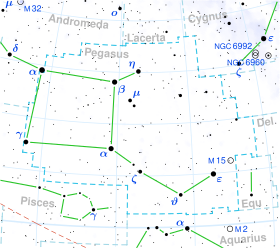| Observation data Epoch J2000 Equinox J2000 | |
|---|---|
| Constellation | Pegasus |
| Right ascension | 23h 07m 06.74364s[1] |
| Declination | 25° 28′ 05.788″[1] |
| Apparent magnitude (V) | 4.74[2] |
| Characteristics | |
| Spectral type | K0.5II:Ba1CN-2CH-0.5[3] + sdO[4][5] |
| U−B color index | +1.14[2] |
| B−V color index | +1.32[2] |
| Astrometry | |
| Radial velocity (Rv) | −27.55[6] km/s |
| Proper motion (μ) | RA: −4.288[1] mas/yr Dec.: −32.639[1] mas/yr |
| Parallax (π) | 6.1131 ± 0.4108 mas[1] |
| Distance | 530 ± 40 ly (160 ± 10 pc) |
| Absolute magnitude (MV) | −1.32[7] |
| Orbit[5] | |
| Period (P) | 111.140±0.14 d |
| Eccentricity (e) | 0 |
| Periastron epoch (T) | 51738.8±0.5 MJD |
| Semi-amplitude (K1) (primary) | 1.47±0.04 km/s |
| Details | |
| 56 Peg A | |
| Mass | 5.4[8] M☉ |
| Radius | 41[9] R☉ |
| Luminosity | 18.2 - 18.9[9] L☉ |
| Surface gravity (log g) | 0.50[10] cgs |
| Temperature | 4,185±85[9] K |
| Metallicity [Fe/H] | −0.21[11] dex |
| Rotational velocity (v sin i) | 4.4[12] km/s |
| Age | 100±100[8] Myr |
| Other designations | |
| Database references | |
| SIMBAD | data |
56 Pegasi is a binary star system in the northern constellation of Pegasus. It is visible to the naked eye with a combined apparent visual magnitude of 4.74.[2] The system is approximately 590 light years away from the Sun based on parallax,[14] but is drifting closer with a radial velocity of −28 km/s.[6] It is listed as a member of the Wolf 630 moving group.[15]
The variable radial velocity of this star was announced in 1911 by W. W. Campbell. It is a single-lined spectroscopic binary in an assumed circular orbit with a period of 111.1 days. The a sin i value for this system is 0.01511 ± 0.00040 AU (2.26 ± 0.06 Gm), where a is the semimajor axis and i is the (unknown) orbital inclination. This value provides a lower bound on the true semimajor axis, which in this case is their actual separation.[5]
The primary component is a peculiar bright giant with a stellar classification of K0.5 II: Ba1 CN-2 CH-0.5.[3] This notation indicates it is a K-type giant with some uncertainty about the classification, along with an overabundance of barium and underabundances of the CN and CH radicals. It is an active star,[16] roughly 100 million years old, with 5.4 times the Sun's mass.[8] The star has expanded to 40[17] times the radius of the Sun and is radiating 680[11] times the Sun's luminosity from its enlarged photosphere at an effective temperature of 4,416 K.[18]
The system displays an excess of ultraviolet radiation that must be coming from the secondary companion. Simon et al. (1982) classified this object as a subdwarf O star.[4] Alternatively, it may be a white dwarf companion with an accretion disk.[19][5] Several puzzling features in the evolutionary history of this pair may be explained if the primary is a fast rotator being seen nearly pole-on. The star may have been spun up during a mass transfer episode with the secondary.[16]
- ^ a b c d e Cite error: The named reference
dr2was invoked but never defined (see the help page). - ^ a b c d Cite error: The named reference
ducatiwas invoked but never defined (see the help page). - ^ a b Cite error: The named reference
perkins1989was invoked but never defined (see the help page). - ^ a b Cite error: The named reference
simonwas invoked but never defined (see the help page). - ^ a b c d Cite error: The named reference
griffinwas invoked but never defined (see the help page). - ^ a b Cite error: The named reference
Famaey2005was invoked but never defined (see the help page). - ^ Cite error: The named reference
frankowskiwas invoked but never defined (see the help page). - ^ a b c Cite error: The named reference
Tetzlaff2011was invoked but never defined (see the help page). - ^ a b c Cite error: The named reference
messiniowas invoked but never defined (see the help page). - ^ Cite error: The named reference
Soubiran2016was invoked but never defined (see the help page). - ^ a b Cite error: The named reference
XHIPwas invoked but never defined (see the help page). - ^ Cite error: The named reference
deMedeiros1999was invoked but never defined (see the help page). - ^ Cite error: The named reference
SIMBADwas invoked but never defined (see the help page). - ^ Cite error: The named reference
hipparcoswas invoked but never defined (see the help page). - ^ Cite error: The named reference
Bubar2010was invoked but never defined (see the help page). - ^ a b Cite error: The named reference
Frankowski2006was invoked but never defined (see the help page). - ^ Cite error: The named reference
vanBelle2009was invoked but never defined (see the help page). - ^ Cite error: The named reference
Perez2011was invoked but never defined (see the help page). - ^ Cite error: The named reference
Schindler1982was invoked but never defined (see the help page).
